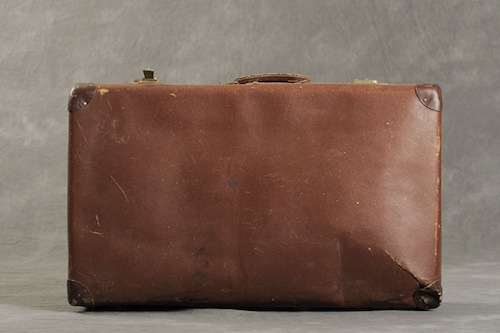
Image Credit: Jon Crispin
Beaten up, bulging, and with one latch ajar, this old suitcase beckons to be opened. It was closed for a long time, deposited with its owner in 1953 at the Willard Asylum for the Insane near Seneca Lake, NY. This and around 400 other suitcases that belonged to the asylum's patients sat for many years, forgotten in the attic of the defunct facility until discovered in the mid-1990s. After being exhibited publically for the first time in 2004, many of the suitcases are now temporarily in the care of Jon Crispin who has undertaken to photograph the collection. The images in this post are from Crispin's blog which chronicles his experience inspecting and documenting the personal effects of the Willard patients.

Image Credit: Jon Crispin
On his blog, Crispin visually "unpacks" the suitcases for viewers, first presenting their tough-looking exteriors, then their inner compartments and finally, through close ups, individual items themselves. This photographic unveiling seems intended to simulate the experience of first discovering and opening the parcels (some of which date back to the 1920s). The open-face pictures have a luminous quality that evokes the revelatory experience of opening a present, or hoisting up the lid of an old costume box. Like beautiful clamshells, the suitcases cradle their contents in a visually striking way. Most are lined with fabric or pretty yellowed paper which gives the objects strewn inside them a personal, familiar, and strangely cheerful feel.
The paraphernalia radiate cheeriness in spite of, or almost in defiance of, the fate of institutional confinement that lurks behind each photograph. There are plenty of generic items in the cases, like hair combs and safety pins, but also stuff that has a very personal logic to it: biographically significant items that suggest the suitcase owners led full and interesting lives, at least before they were "put away." The case at the top of the page for instance belonged to a Ukrainian emigree who we know made a model of a church from his native country and gave it to President Truman. (The model was apparently impressive enough to find a home in a government building in Washington). The patient was also a prodigious painter while at Willard, which makes his collection of postcards, photos, prints and souvenirs of special interest. It is interesting to think of this case as an artistic wellspring, a physical container of ideas from the outside world that, at some point, might well have found their way into the patient's creations. More fascinating still is the notion that this artist's private suitcase has become, under Crispin's artistic supervision, a still life in its own right.

Image Credit: Jon Crispin
This green suitcase, or sturdy trunk rather, belonged to a World War II veteran named Frank who was living in Brooklyn in 1945 when the police committed him to the psych wards for publically protesting a social slight. Even before I read about his tragic story, Frank's suitcase stood out to me because his possessions somehow make him seem knowable, even present. The miniature note books, the shipping tags, the posed photographs, and scraps brought back from serving overseas all suggest that he liked to thoughtfully record and remember experiences.
Frank's nostalgia, his comfortable air behind the camera, his propensity for self-portraiture and interest in memorabilia make him feel almost like a peer of ours, say, a person who would feel right at home using Instagram. But there's something eery about how close he feels to us. It's almost as if Frank, or whoever packed his suitcase, knew that it would become a time capsule of sorts, the only means through which future generations would get to know the handsome, dignified man in the photographs. I wish I could thank him for leaving us such a beautiful object-memoir of his life.

Image Credit: Jon Crispin




Recent comments
2 years 29 weeks ago
2 years 44 weeks ago
2 years 44 weeks ago
2 years 50 weeks ago
3 years 4 weeks ago
3 years 4 weeks ago
3 years 4 weeks ago
3 years 6 weeks ago
3 years 6 weeks ago
3 years 6 weeks ago